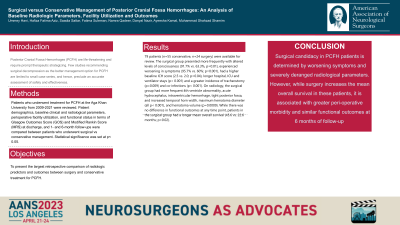Surgical versus Conservative Management of Posterior Cranial Fossa Hemorrhages: An Analysis of Baseline Radiologic Parameters, Facility Utilization and Outcomes
Friday, April 21, 2023

.jpeg.jpg)
Ummey Hani, MBBS
Postdoctoral Research Fellow
Carolina Neurosurgery & Spine Associates
Charlotte, North Carolina, United States
ePoster Presenter(s)
Introduction: Posterior Cranial Fossa Hemorrhages (PCFH) are life-threatening and require prompt therapeutic strategizing. Few studies recommending surgical decompression as the better management option for PCFH are limited to small case series, and hence, preclude an accurate assessment of safety and effectiveness. Herein, we present the largest retrospective comparison of radiologic predictors and outcomes between surgery and conservative treatment for PCFH.
Methods: Patients who underwent treatment for PCFH at the Aga Khan University from 2009-2021 were reviewed. Patient demographics, baseline clinical and radiological parameters, perioperative facility utilization, and functional status in terms of Glasgow Outcomes Score (GOS) and Modified Rankin Score (MRS) at discharge, and 1- and 6-month follow-ups were compared between patients who underwent surgical vs conservative management. Statistical significance was set at p< 0.05.
Results: 79 patients (n=55 conservative, n=24 surgery) were available for review. The surgical group presented more frequently with altered levels of consciousness (91.7% vs. 63.3%, p=0.01), experienced worsening in symptoms (95.7% vs. 60%; p=0.001), had a higher baseline ICH score (2.5 vs. 2.0; p=0.04), longer hospital, ICU and ventilator stays (p < 0.001) and a greater incidence of tracheostomy (p=0.009) and co-infections (p < 0.001). On radiology, the surgical group had more frequent 4th ventricle abnormality, acute hydrocephalus, intraventricular hemorrhage, tight posterior fossa, and increased temporal horn width, maximum hematoma diameter (all p< 0.001), and hematoma volume (p=0.0009). While there was no difference in functional outcomes at any time point, patients in the surgical group had a longer mean overall survival (45.6 vs. 22.6 months; p=0.02).
Conclusion : Surgical candidacy in PCFH patients is determined by worsening symptoms and severely deranged radiological parameters. However, while surgery increases the mean overall survival in these patients, it is associated with greater peri-operative morbidity and similar functional outcomes at 6 months of follow-up.
Methods: Patients who underwent treatment for PCFH at the Aga Khan University from 2009-2021 were reviewed. Patient demographics, baseline clinical and radiological parameters, perioperative facility utilization, and functional status in terms of Glasgow Outcomes Score (GOS) and Modified Rankin Score (MRS) at discharge, and 1- and 6-month follow-ups were compared between patients who underwent surgical vs conservative management. Statistical significance was set at p< 0.05.
Results: 79 patients (n=55 conservative, n=24 surgery) were available for review. The surgical group presented more frequently with altered levels of consciousness (91.7% vs. 63.3%, p=0.01), experienced worsening in symptoms (95.7% vs. 60%; p=0.001), had a higher baseline ICH score (2.5 vs. 2.0; p=0.04), longer hospital, ICU and ventilator stays (p < 0.001) and a greater incidence of tracheostomy (p=0.009) and co-infections (p < 0.001). On radiology, the surgical group had more frequent 4th ventricle abnormality, acute hydrocephalus, intraventricular hemorrhage, tight posterior fossa, and increased temporal horn width, maximum hematoma diameter (all p< 0.001), and hematoma volume (p=0.0009). While there was no difference in functional outcomes at any time point, patients in the surgical group had a longer mean overall survival (45.6 vs. 22.6 months; p=0.02).
Conclusion : Surgical candidacy in PCFH patients is determined by worsening symptoms and severely deranged radiological parameters. However, while surgery increases the mean overall survival in these patients, it is associated with greater peri-operative morbidity and similar functional outcomes at 6 months of follow-up.
